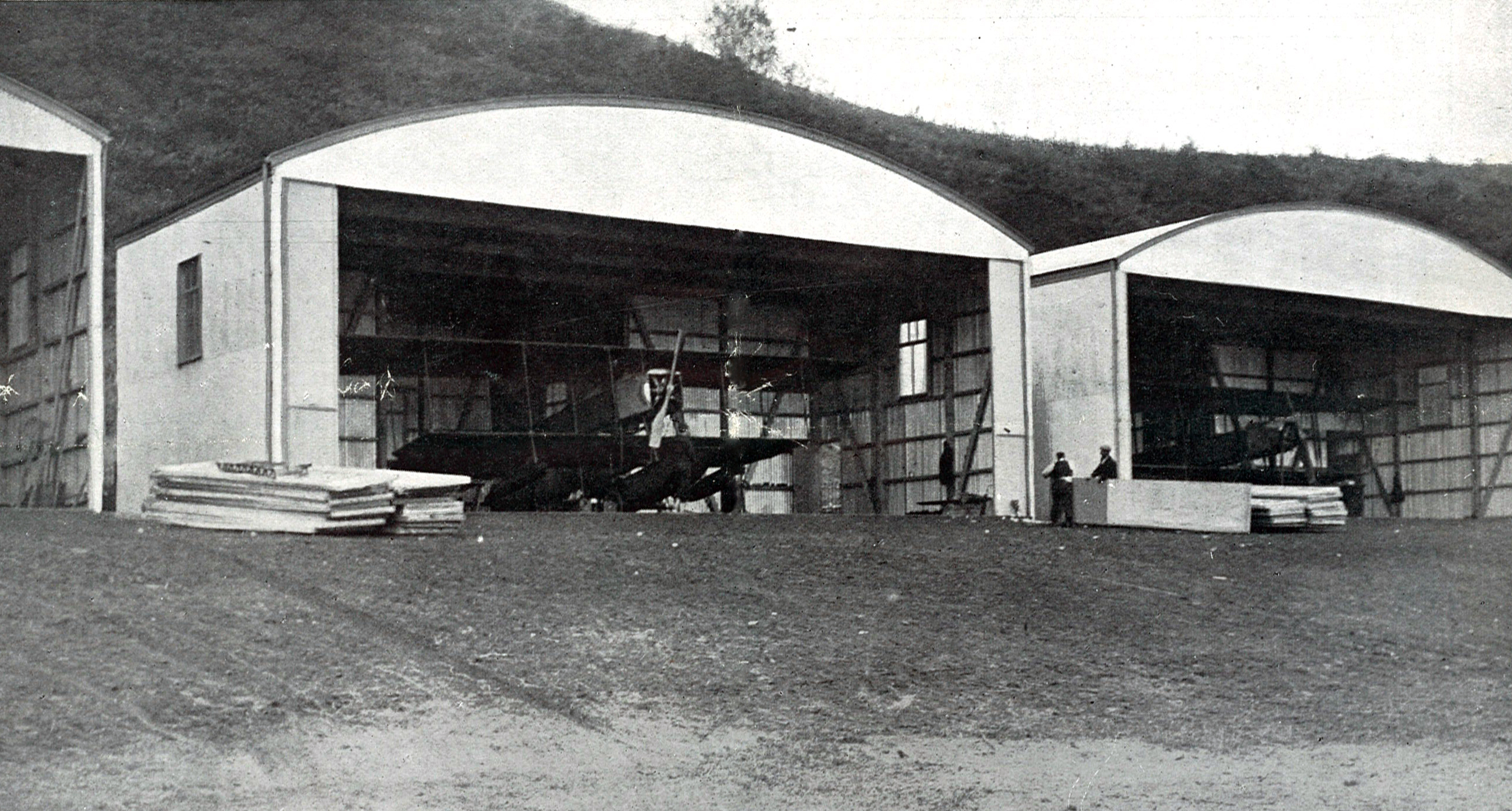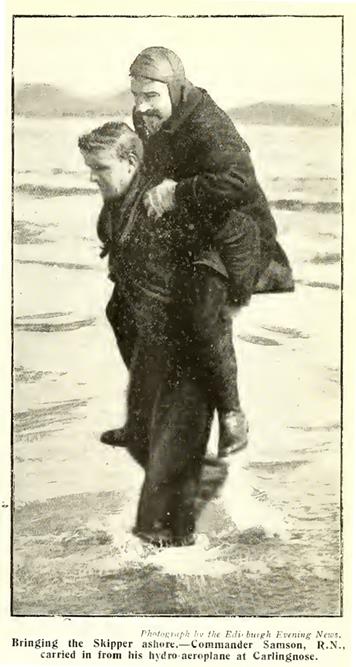1912 – Flying round the Forth
| < Carlingnose Air Station | Δ Index | Spotting Submarines > |
Scotsman – Thursday 3rd October 1912 – Page 9
FLIGHT OVER THE FORTH
Yesterday forenoon the new hydroplane station established at Port Laing, near North Queensferry, was opened by two flights being carried out by Commander Samson and Captain Gordon. Three machines have been placed in the hangars, and would have operated previously, but the very stormy weather experienced at the beginning of the week precluded all possibility of any attempt at flying being made, more especially as the wind has been persistently from the east and north-east.
 Aircraft in the hangers at Port Laing
Aircraft in the hangers at Port Laing
With the improvement which has set in in the weather during the night, it became known that flying would be engaged in yesterday morning and at a comparatively early hour people were seen concentrating on Port Laing form the surrounding district. When the hangar of No. 10 hydroplane was thrown open Commander Samson, having made a preliminary examination directed its removal to the sandy beach whence it was launched by a strong force of bluejackets. The carrying wheels however, lodged in the soft sand at high water mark, and the services of some fifty navvies on strike from Rosyth Naval Base were called to the aid of the launching party, and the machine was soon dragged again to solid ground.
 Stuck in the mud
Stuck in the mud
“A long pull and a strong pull all together” – Although the picture only shows strikers from Rosyth hauling Commander Samson’s Short biplane out of the mud at Carlingnose on the Firth of Forth it may be taken as an allegory for the Aeroplane Industry being hauled out of the Slough of Prejudice by the combined efforts of certain Members of Parliament and the Press.
From a more satisfactory launching ground the biplane was soon riding in the light surf, which was coming in with the rising tide, and at 11.47, with a mechanic on board, Commander Samson set his engine in motion and sped over the surface of the water. In two minutes the aeroplane, steering a course north-east by east, into the teeth of a fresh north-easterly breeze rose from the water into the air, and sailed gracefully and rapidly away in a straight line for Inchcolm Island. Passing the island to the south at a moderate height, the plane again came down to the surface, gracefully swept to the right into a southerly course, and then again round to one for the Forth Bridge. When off Dalmeny Park a deviation towards the north was again made, and rising once more from the sea it swept round and made a line for the landing place, coming one more to the surface before it was safely beached, about fifty yards from the water mark. Commander Samson expressed his satisfaction at the working of his engines. Afterwards Captain Gordon ran out his No. 5 hydroplane, supplied with a seventy horse-power engine and thoroughly tested it on the beach. A circuit similar to that made by No. 10 hydroplane was also most satisfactorily accomplished.
It is learned that operations on a more extensive scale will take place today.
The Aeroplane – OCTOBER 10, 1912 Page 366
Naval and Military Aeronautics. – GREAT BRITAIN.
The new naval aeroplane base at Carlingnose, near Rosyth, on the Firth of Forth, was officially used for the first time on October 2nd, when flights were made by Commander Samson, R.N., on a 100-h.p. Short tractor hydro-biplane, and by Capt. Gordon, R.M.L.I., on a Short 70-h.p. hydro-biplane. The handling of the machines on the muddy beach appeared to be somewhat difficult, and a number of navvies on strike from Rosyth lent a hand in hauling them ashore.
It will be remembered that a considerable time ago it was pointed out in The Aeroplane that, in view of German aeronautical activity at Heligoland and Wilhelmshaven, it would be necessary for us to establish stations for coast defence aeroplanes along the east coast. A certain amount of work has already been done at Harwich, but Carlingnose is the first properly-established station. No doubt, in due course, similar stations will fee made at Tynemouth, Teesmouth, in the Wash, and at other points along the coast. It is already announced that a station is to be established at Cleesthorpe to guard the mouth of the Humber.
Captain Gordon unfortunately turned the 70-h.p. tractor over on Friday. The incident is described by an eye-witness as follows :—” I had a rather good view of the capsizing of Captain Gordon’s Short machine on Friday afternoon, as I was watching him throughout his trip with a telescope. He was travelling on the water, seemingly throttled down, with the wind dead astern, and the machine evinced tendencies to plunge the right wing-tip into the water, and seemed unstable on the float. He then tried turning—not very gradually—to the right to bring himself head to wind for rising. As he turned the wind lifted his right planes, and the passenger (Lieut. Hewlett) climbed out at the starboard side of the fuselage and stretched out to the first inter-plane struts to counteract the side wind. This was not sufficient, and when broadside on to the wind the machine dipped the port lower wing-tip. The pilot immediately switched off, and the propeller entered the water practically at rest. The machine then slowly did a somersault to port, the passenger climbing out on top as it turned. Captain Gordon did not appear till later, but eventually joined his passenger on top. The machine floated towards one side, and of course down by the head. Assisted by fleet boats, the machine was towed back again.”



October 1912 – Flying Over the Forth
Flight Global – October 19th 1912
Some splendid flying was seen from the Carlingnose aviation base on the Firth of Forth at the end of last week, and each day Commander Samson, Capt. Gordon, and Lieut. Hewlett were in the air. A number of experiments in bomb-throwing and in reconnoitring over torpedo boats and submarines have been carried out, while a large number of passengers, mostly naval officers, have been taken for trips. Lieut. Hewlett also carried out some tests in signalling to warships by means of a syren. The flying has attracted large crowds each day, who have witnessed the work from Port Laing, North Queensbury [sic].
| < Carlingnose Air Station | Δ Index | Spotting Submarines > |